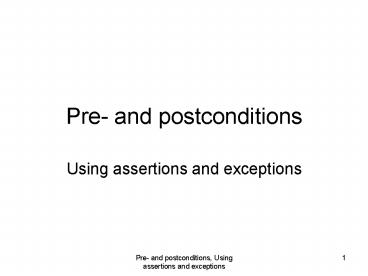Pre- and postconditions - PowerPoint PPT Presentation
1 / 12
Title: Pre- and postconditions
1
Pre- and postconditions
- Using assertions and exceptions
2
Design by contract
- Idea
- A program is correct if given correct input the
program produces correct output. - Correct input ? PROGRAM ? correct output
- A program is considered a kind of black box
- Same idea applies to parts of a program
- Methods, functions, etc.
- Correct input ? METHOD ? correct output
- Precondition
- Specification of correct input
- Postcondition
- Specification of correct output
3
Pre- and postconditions
- Statement that evaluates to true or false
- Many Java methods have a precondition
- Class.forName(String className)
- Assumes className ! null and that the class
exists. - Integer.parseInt(String s)
- Assumes that the String s contains a number
- If you dont respect the precondition the methods
will most likely throw some kind of (runtime)
exception - NullPointerException
- NumberFormatException
- A subclass of IllegalArgumentException
- In Java pre- and postconditions are not part of
method signatures - You can specify pre- an postconditions as
comments
4
Pre- and postconditions used with method
overriding
- class S
- // pre A post B
- method(int p)
- class T extends S
- // pre X post Y
- method(int p)
- X can be weaker than A
- Y can be stronger than B
- Example
- A p gt 0 disallows 0
- X p 0 allows 0
- B
- result is true or false
- Example Collection.add()
- Y
- result is always true
- Example List.add()
5
Invariant
- An invariant is a statement that is invariably
true. - Class invariant
- Statement about the objects state between method
invocation - Loop invariant
- Statement about the state of variables in a loop
6
Proof of post condition
- The idea of introducing pre- and postconditions
is to formally (mathematically) prove the
postcondition from the preconditions - Precondition AND program implies post condition
- An invariant may help doing the proof.
- However, often the proof can be quite hard to do.
- Usually only done in critical systems
- Controlling hospital equipment, satellites, etc.
- Usually more errors in the proof than in the
program - But gives you a chance to rethink you program.
7
Assertions in Java
- Assertions is a relatively new feature if Java
- Since Java 1.4
- Prior to Java 1.4 programmers had to program
their own assertion facility. That is no longer
necessary or advisable. - New keyword assert
- assert booleanExpression
- assert booleanExpression errorMessage
- Example
- if (direction LEFT) doLeft()
- else if (direction RIGHT) doRight()
- else
- assert false Bad direction
8
Enabling assertions
- The Java compiler must be explicitly informed
that you have assertions in your program - javac source 1.4 SomeClass.java
- You tell the compiler that your source code is
Java version 1.4 - Reason
- Assert is a new keyword. Some older program may
have used assert to name a variable or a method. - The Java virtual machine (JVM) must be explicitly
informed to check assertions - java ea SomeClass
- -ea means enable assertions
- Reason
- Checking assertions takes time. You only want to
check assertions during testing and debugging,
not when the program is running at the customers
site.
9
Enabling assertions in NetBeans
10
When not to use assertions
- Checking parameters to public methods
- Dont use assertions to check parameters on
public methods - Assertion checking disabled when the program is
running at the customers site. - You cannot otherwise control the validity of
parameters to public methods. - Check (using an if-statement) that the parameters
are valid. If not throw - NullPointerException
- IllegalArgumentException, or one of its subclasses
11
When to use assertions
- Checking parameters to private methods
- You control who calls private methods.
- When things work (you are no longer debugging)
then you can safely disable assertion checking. - Checking conditions in methods
- Where parameters have been checked without using
exceptions.
12
References
- Ken Arnold et al The Java Programming Language,
4th edition, Addison Wesley 2006 - 12.8 Assertions, page 296-303
- Sun Microsystems Programming with Assertions
- http//java.sun.com/j2se/1.4.2/docs/guide/lang/ass
ert.html - Qusay H. Mahmoud Using Assertions in Java
Technology, Sun Microsystems 2005 - http//java.sun.com/developer/technicalArticles/Ja
vaLP/assertions/































